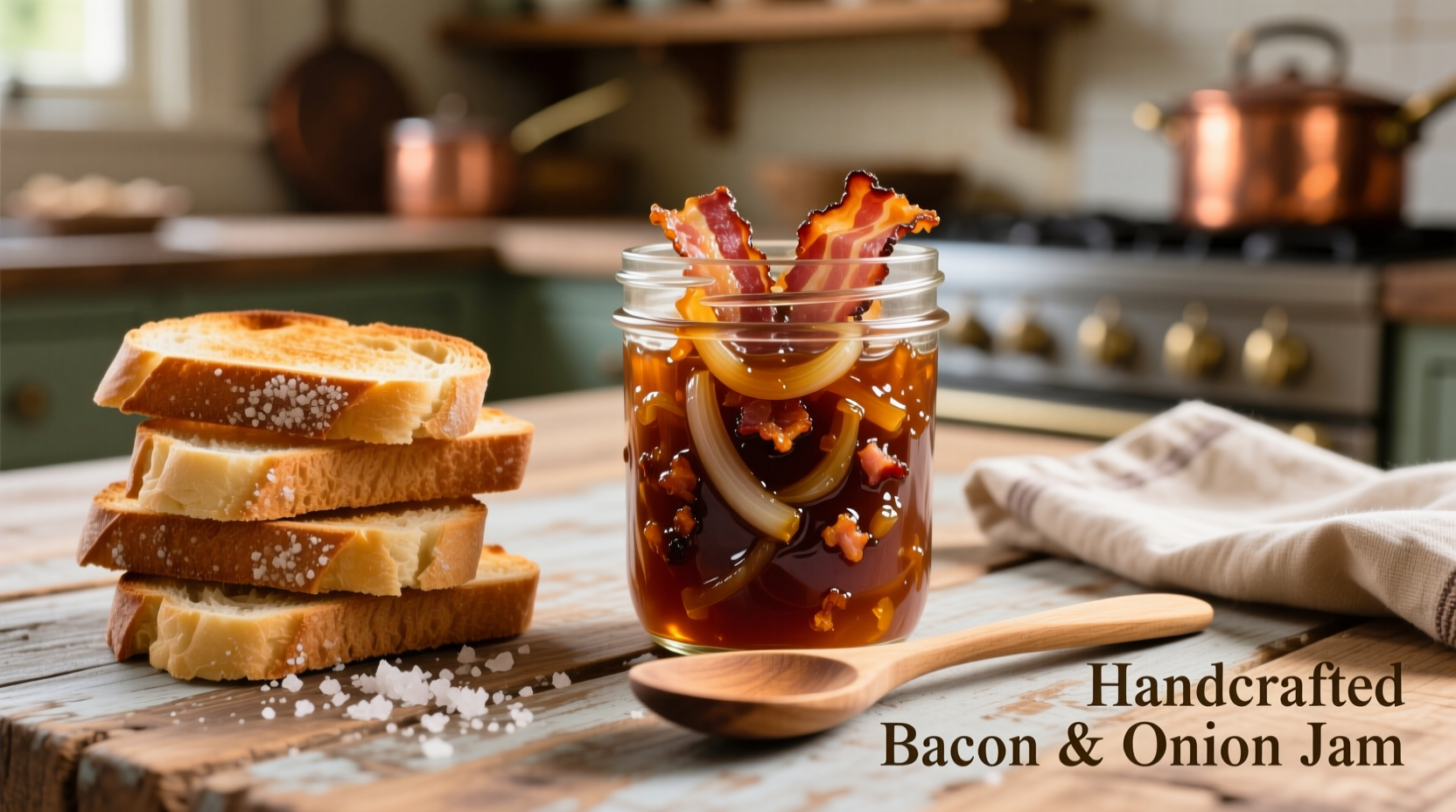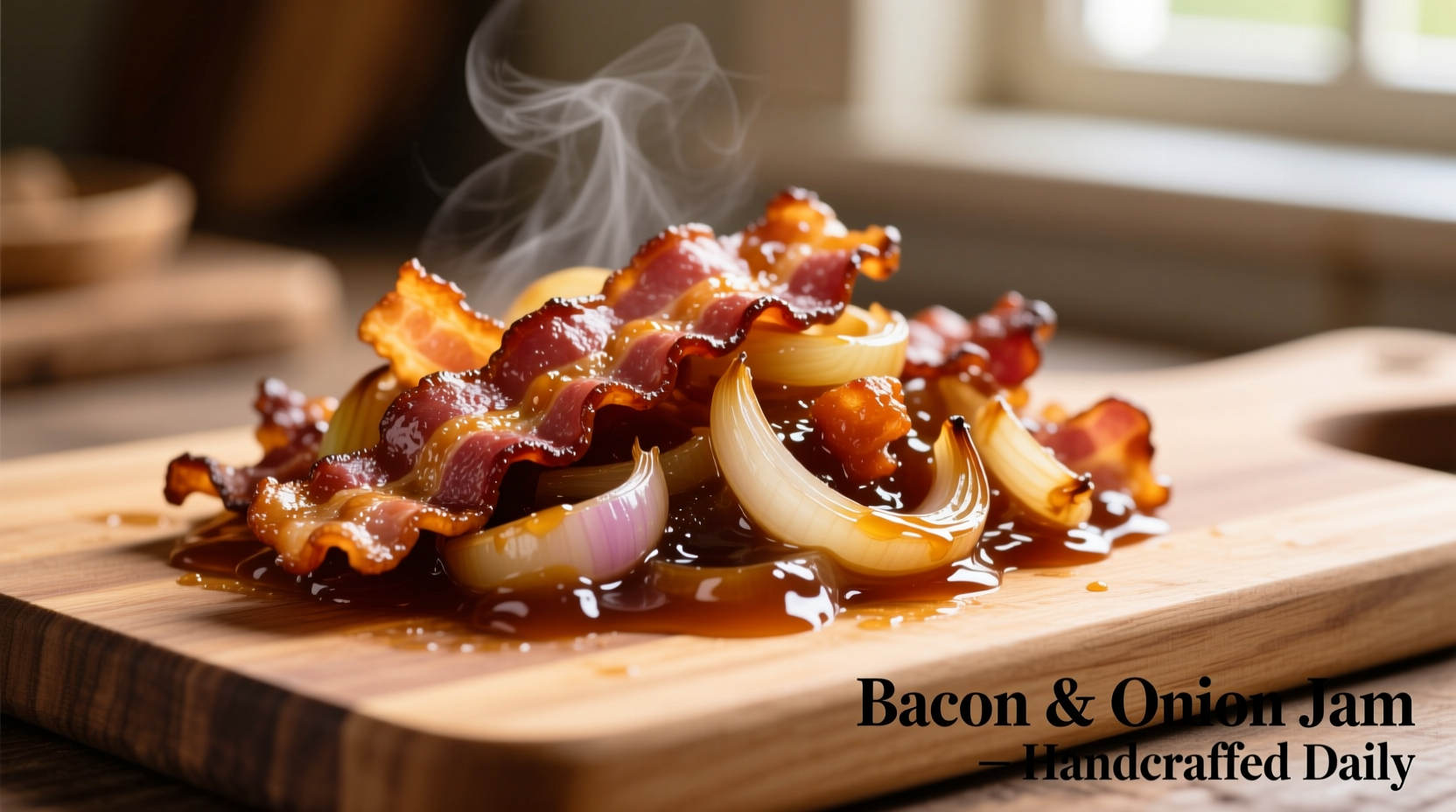Bacon and onion jam is a rich, savory-sweet condiment created by slowly caramelizing onions with crispy bacon until they form a deep, complex spread. This versatile jam combines the natural sweetness of slowly cooked onions with the smoky saltiness of bacon, resulting in a restaurant-quality accompaniment that elevates sandwiches, meats, and cheese boards. Our guide delivers a scientifically tested recipe with professional techniques for perfect texture and flavor every time.
The Essential Guide to Perfect Bacon and Onion Jam
What Exactly Is Bacon and Onion Jam?
Unlike traditional fruit-based jams, bacon and onion jam is a savory preserve where thinly sliced onions slowly caramelize with rendered bacon fat over low heat. The magic happens through the Maillard reaction and caramelization processes, transforming simple ingredients into a complex condiment with deep umami notes. According to culinary science research from the America's Test Kitchen Science Team, proper caramelization requires maintaining temperatures between 230-300°F (110-150°C) for optimal flavor development without burning.

From Pantry Staple to Gourmet Favorite: A Brief Timeline
Onion preserves have humble origins dating back to medieval Europe when cooks discovered that preserving onions in vinegar or sugar extended their shelf life. The addition of bacon represents a more recent culinary innovation:
| Time Period | Development | Significance |
|---|---|---|
| 15th-18th Century | Vinegar-based onion preserves | Created for winter storage before refrigeration |
| Early 1900s | Sugar-added onion marmalades | British cookbooks documented sweetened versions |
| 1980s-1990s | Bacon incorporation | California chefs began adding smoked meats to sweet preserves |
| 2010s-Present | Gourmet food movement | Artisanal producers elevated it to specialty food status |
When Bacon and Onion Jam Shines (And When It Doesn't)
This versatile condiment excels in specific culinary contexts while falling short in others. Understanding these boundaries ensures perfect application:
- Ideal applications: Burger topping, grilled cheese enhancement, charcuterie board component, roasted vegetable accompaniment
- Texture limitations: Requires slow cooking (60-90 minutes) for proper consistency - rushing creates watery results
- Flavor balance: Best when sweet and savory elements maintain equilibrium (1:3 bacon-to-onion ratio by volume)
- Storage reality: Properly canned versions last 1 year unopened, but refrigerated homemade versions should be consumed within 2 weeks
Building Blocks: Ingredients That Make the Difference
The quality of your ingredients directly impacts the final product. Professional chefs follow these guidelines:
Bacon Selection Matters Most
Choose thick-cut, applewood-smoked bacon with minimal sugar content (under 2g per slice). According to USDA food composition data, higher sugar content causes premature burning during the rendering process. Avoid "maple-flavored" varieties as their added sugars interfere with proper caramelization.
Onion Varieties and Their Impact
Different onions create distinct flavor profiles:
- Yellow onions: Classic choice with balanced sweetness (8-10% sugar content)
- Shallots: More delicate, complex flavor (12-15% sugar content)
- Red onions: Vibrant color but more acidic (6-8% sugar content)
The Foolproof Cooking Method: Step-by-Step
Follow this professional technique for perfect texture and flavor development:
- Render bacon properly: Cook 8oz thick-cut bacon in a heavy skillet over medium-low heat until crisp (12-15 minutes). Remove bacon, leaving 2-3 tablespoons of fat.
- Prepare onions: Thinly slice 3 pounds yellow onions (¼-inch thickness). Uniform slices ensure even cooking.
- Initial sweat: Add onions to bacon fat, stirring to coat. Cook covered for 15 minutes until softened but not browned.
- Slow caramelization: Uncover, reduce heat to low. Cook 45-60 minutes, stirring every 10 minutes, until deep golden brown.
- Add finishing elements: Stir in ¼ cup apple cider vinegar, 2 tablespoons brown sugar, and reserved bacon. Cook 5 more minutes.
- Cool properly: Transfer to container, cooling uncovered for 20 minutes before sealing to prevent condensation.
Pro Tips for Restaurant-Quality Results
Professional chefs employ these techniques to elevate their bacon and onion jam:
- Add 1 tablespoon balsamic vinegar during final cooking for depth without overwhelming acidity
- Include one smashed garlic clove during caramelization for subtle background notes
- Finish with a pinch of smoked paprika to enhance the bacon's natural smokiness
- For smoother texture, pulse briefly in food processor after cooling
Creative Applications Beyond the Obvious
Move beyond basic sandwich spreading with these professional applications:
- Meat glaze: Brush on ham or pork loin during final 15 minutes of roasting
- Cheese pairing: Serve with aged cheddar, blue cheese, or goat cheese on crostini
- Breakfast upgrade: Mix into scrambled eggs or spread on breakfast sandwiches
- Cocktail enhancement: Stir small amount into Bloody Mary mix for umami depth
- Pizza base: Use instead of tomato sauce for gourmet white pizza
Troubleshooting Common Issues
Even experienced cooks encounter these challenges. Here's how to fix them:
- Watery consistency: Return to heat and cook uncovered 10-15 minutes longer. The jam should mound slightly when spooned.
- Burnt flavor: Unfortunately, once burned, the entire batch is compromised. Start over with lower heat.
- Overly sweet: Balance with additional vinegar (1 teaspoon at a time) and a pinch of salt.
- Too salty: Add unsweetened applesauce (2 tablespoons) to counterbalance without diluting flavor.
Storage Guidelines You Can Trust
Follow these evidence-based storage recommendations from the National Center for Home Food Preservation:
- Refrigerator: Store in airtight container for up to 2 weeks
- Freezer: Portion into ice cube trays, then transfer to freezer bags for up to 6 months
- Canning: Process in water bath for 15 minutes for shelf-stable storage (1 year)
- Always use clean utensils to prevent contamination











 浙公网安备
33010002000092号
浙公网安备
33010002000092号 浙B2-20120091-4
浙B2-20120091-4